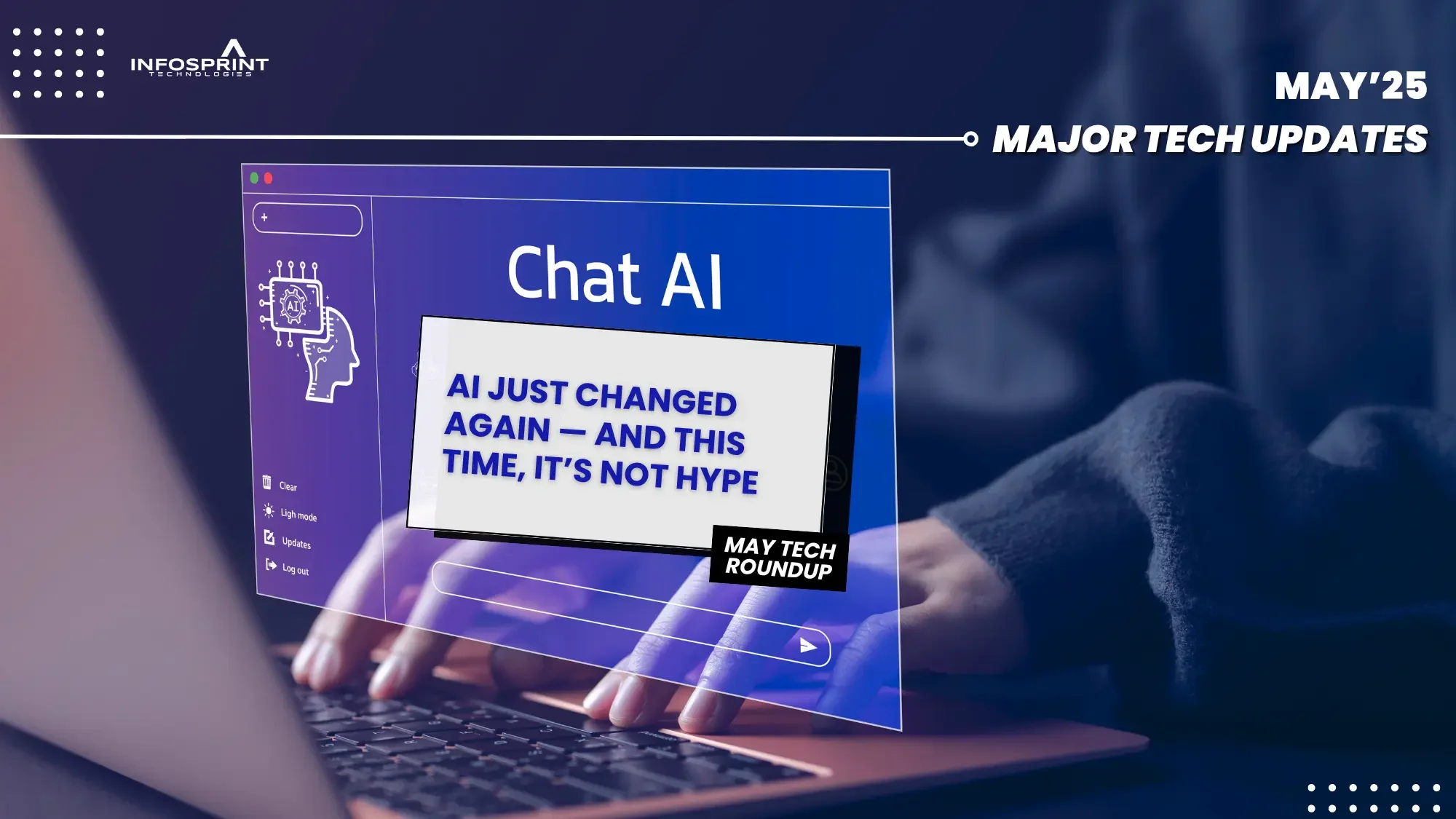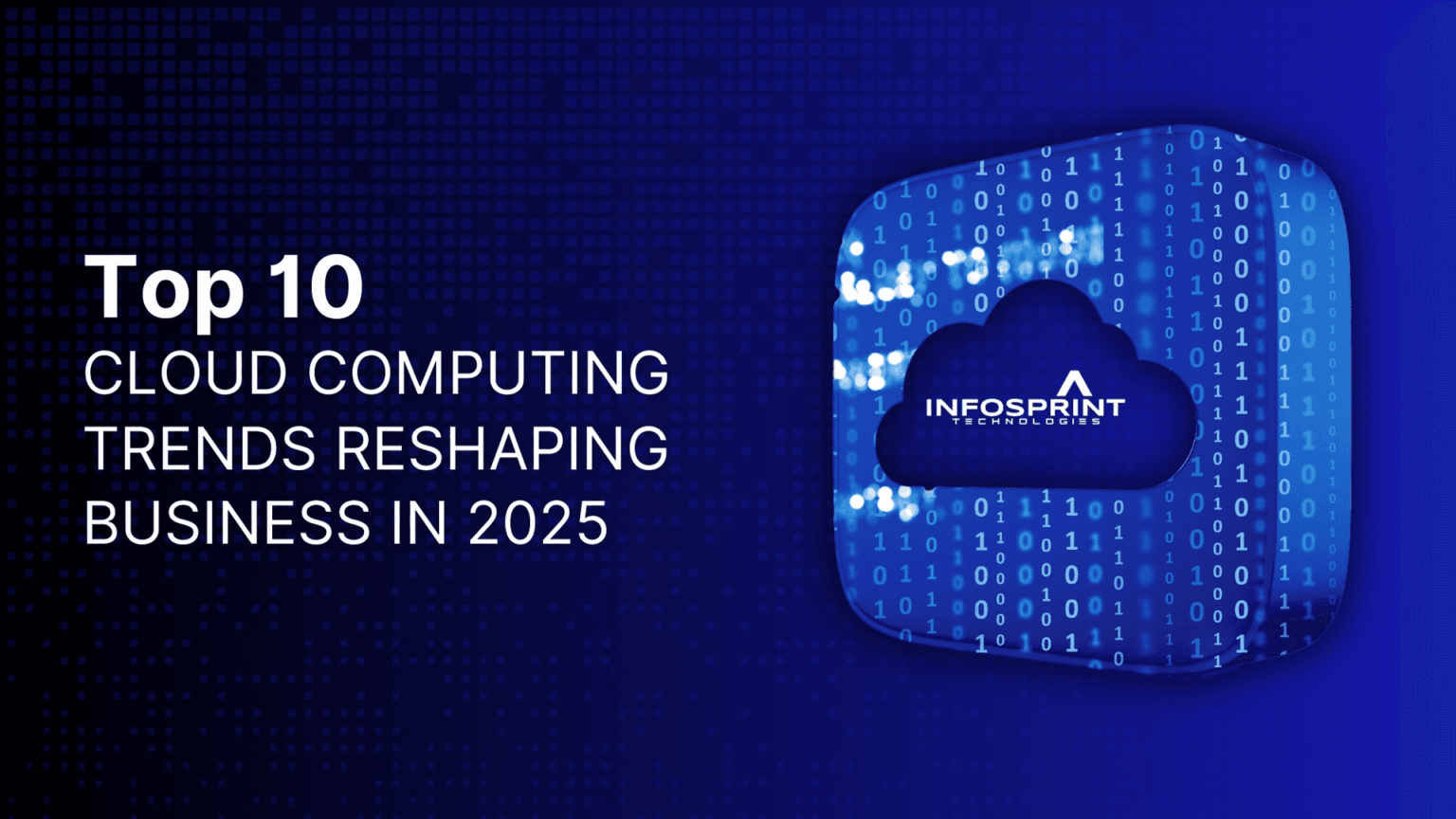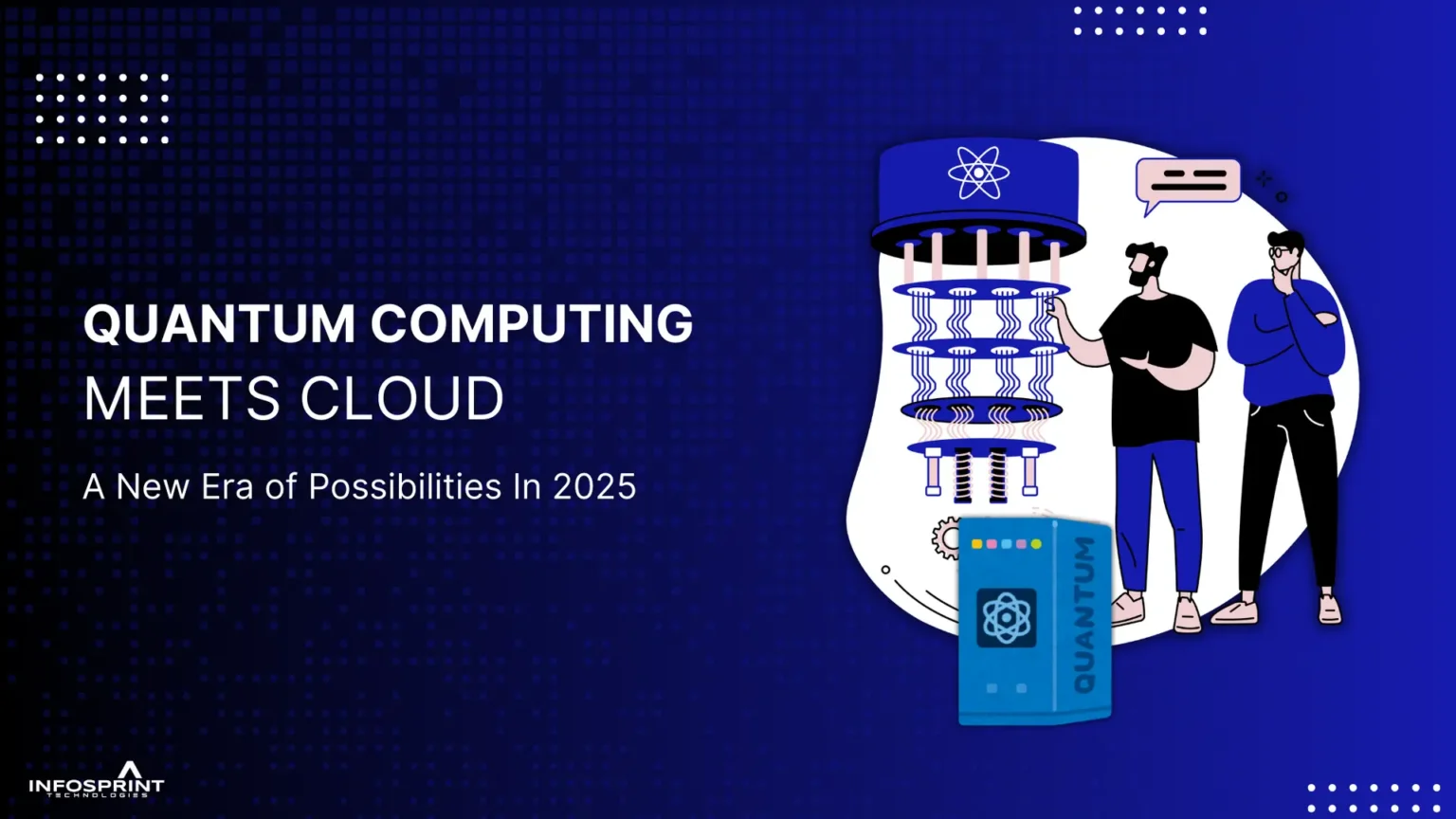May 2025 Tech Roundup: 5 Trends Signaling What’s Next

On this Page
- AI Breakthroughs Are Shaping Competitive Advantage
- OpenAI & Jony Ive’s io: Reimagining AI Hardware
- Google I/O 2025: Gemini Live, Imagen 4 & Veo 3 Expand AI Creativity
- Claude 4 by Anthropic: Advancing AI for Coding and Enterprises
- Nvidia’s AI Boom: Still the Backbone of AI Infrastructure
- Microsoft’s Copilot+ PCs: The AI-Powered Endpoint Revolution
- May 2025 Marked a New Era in AI
May: The Month AI Took Over.
From tech giants racing to acquire AI startups to businesses ramping up budgets for more innovative, faster, more capable models, this month has shown one clear truth: AI innovation waits for no one.
These shifts aren’t limited to one sector. Whether you’re in retail, healthcare, finance, or beyond, how you lead, scale, and compete will be reshaped by the pace of AI. Staying ahead is no longer optional — it’s your edge.
Infosprint Technologies is an IT service company that works at the forefront of IT and AI, helping enterprises navigate this evolving landscape. We broke down the most impactful AI milestones of May — from cutting-edge developments and major mergers to hardware breakthroughs — and what they mean for your next tech move.
AI Breakthroughs Are Shaping Competitive Advantage
May was a blockbuster month for artificial intelligence. Companies are no longer asking whether they should adopt AI, but rather how quickly they can do it.
1. OpenAI & Jony Ive’s io: Reimagining AI Hardware
In a bold move, OpenAI announced its acquisition of io, the design-focused hardware company founded by legendary Apple designer Jony Ive. The $6.5 billion all-stock deal merges io’s 55-person hardware team into OpenAI, with Ive’s LoveFrom continuing to lead the design of next-generation AI devices.
What’s the vision? Not just another smartphone or headset. Sam Altman describes it as a “new category of AI hardware” — devices designed from the ground up to seamlessly integrate AI into our daily lives.
Why does it matter?
This move signals a significant bet on custom AI gadgets. By pairing Open AI’s research with Ive’s world-class industrial design, the companies aim to create intuitive, beautifully designed AI gadgets.
In a broader ecosystem, this raises the bar for AI hardware innovation – from edge devices to intelligent assistants – and sends a message that hardware design matters as much as software in the era of AI.
What does it mean for businesses?
- Organizations must understand how bespoke AI hardware could fit into existing workflows.
- Companies in consumer electronics, automotive, healthcare, and enterprise IT may need to partner with AI vendors or upgrade prototypes to accommodate these new form factors.
- Hardware vendors and chipmakers will feel pressure to innovate on efficiency and usability
- Supply chains and manufacturing will need to adapt to produce more complex, AI-driven gadgets.
2. Google I/O 2025: Gemini Live, Imagen 4 & Veo 3 Expand AI Creativity
The tech giant Google rolled out game-changing updates to its AI ecosystem — and they’re not just upgrades, they’re enablers. Its new Gemini Live allows users to interact with AI using their phone’s camera and screen in real-time.
The Gemini app now features Gemini Live, a hands-free, always-on camera and screen-sharing interface that’s available for free on both Android and iOS. Think of it as your real-time AI co-pilot — just point your phone at anything and talk it through, from fixing a gadget to solving a math problem on paper. It’s visual problem-solving on demand.
But that’s just the beginning.
Google also embedded two of its most advanced generative models into Gemini:
- Imagen 4, a powerful text-to-image model that creates photorealistic visuals with remarkably accurate text rendering and faster generation speeds.
- Veo 3, a text-to-video engine capable of generating full scenes with native audio, including speech and sound effects, directly from a prompt.
What does it mean for businesses?
- Gemini Live AI can see and converse, so customer service, field tech support, or retail staff could show problems to Gemini and get instant guidance.
- The integration of Imagen 4 and Veo 3 means marketers, influencers, and designers can generate high-quality images and videos.
- AI graphic generators empower organizations to significantly accelerate content creation, shrinking production timelines from weeks to days. Moreover, these tools can democratize creativity by enabling individuals to overcome creative blocks.
- Google’s tight integration of Gemini across Gmail, Docs, and Android apps signals a future where AI is part of every digital workflow.
3. Claude 4 by Anthropic: Advancing AI for Coding and Enterprises
Anthropic made waves with the release of Claude 4, featuring two powerful models: Claude Opus 4 and Claude Sonnet 4. Opus 4, in particular, is being referred to as “the best coding model in the world.”
New features include:
- Claude’s extended memory, which remembers context across sessions
- Claude Code, which integrates directly into tools like GitHub, VS Code, and JetBrains

What does it mean for businesses?
- Benchmark tests confirm that Opus 4 outperforms its peers on coding tasks and can sustain performance over several hours, managing tasks that span thousands of steps.
- Developers gain a powerful AI partner that can perform overnight refactors and run multi-search and debugging autonomously.
- Claud’s automation brings workflow automation closer to reality.
- Organizations can start leveraging Claud to handle repetitive tasks, generate documents and reports, and perform deeper autonomous data analysis.
- Claude is now accessible with Anthropic API, Amazon Bedrock, and Google Vortex AI which means companies have the flexibility to choose the platform that best fits their existing infrastructure.
- ‘Coding first’ push from Claude means Gen AI is increasing support for non-technical developers, which gives recruiting flexibility to organizations.
Infosprint has already integrated Claude to client environments. From custom Claude-powered dev agents to automating backend scripts and auditing AI-generated code, we’re helping businesses unlock serious productivity gains — securely and efficiently.
4. Nvidia’s AI Boom: Still the Backbone of AI Infrastructure
When the CEO of Nvidia compares AI to electricity and the internet, it’s not just visionary talk — it’s backed by numbers that reshape the tech landscape.
In Q1 FY2026 (ending April 2025), Nvidia posted a staggering $44.1 billion in revenue, marking a 69% year-over-year surge. A massive $39.1 billion of that came from its Data Center division alone — a clear sign that demand for AI compute power is not just strong, it’s exploding.
Even with a $4.5 billion inventory charge due to new U.S. export license restrictions (affecting shipments of its H100/H20 chips to China), Nvidia still managed to deliver $4.6 billion worth of those high-demand GPUs before the cutoff.
Meanwhile, Nvidia’s new Blackwell NVL72 “AI supercomputer” chips have entered full production — a move set to cement its dominance further. Huang also revealed a tenfold increase in AI inference token generation over the past year, signaling a new era of enterprise-grade AI workloads.
In short: Nvidia isn’t just riding the AI wave — it’s building the infrastructure behind it.
What companies should watch out for?
- As demand for GPUs skyrockets, businesses deploying GenAI apps will need to manage resource costs smartly.
- Companies building custom models or using image/video generation tools (such as Imagen 4 or Veo 3) should plan for increased compute needs.
- Partnerships with cloud providers (AWS, GCP, Azure) offering Nvidia-powered instances will be key.
5. Microsoft’s Copilot+ PCs: The AI-Powered Endpoint Revolution
Microsoft has officially redrawn the blueprint for personal computing with the launch of Copilot+ PCs — a brand-new class of Windows 11 devices purpose-built for AI.
These next-generation machines combine the classic CPU/GPU architecture with a neural processing unit (NPU) capable of executing over 40 trillion operations per second (TOPS). The result? Laptops and desktops (including Surface, Dell, HP, Lenovo, and more) that can run powerful AI models locally, without relying on the cloud.
Copilot+ PCs are packed with futuristic, AI-native experiences:
- Recall – a searchable, on-device timeline of everything you’ve seen or done.
- Co-Creator – generate or edit images in real-time using natural language.
- Live Captions – perform instant translation of any spoken content on your screen.
Microsoft is calling this a paradigm shift in personal computing, bringing “AI innovation on the device” for the first time at scale. Since late 2024, the company has rolled out more AI-powered features — from super-resolution in Photos to searching files by description — all powered by the local Neural Processing Unit (NPU).
How will this impact businesses?
- Organizations should start evaluating Copilot+ devices for employees who rely on AI-enabled workflows. For example, designers can generate mockups without the internet.
- However, IT teams must manage the devices’ security on which data is shared to cloud AI services.
- Training is also necessary – employees should learn to use voice or camera prompts, and developers must adapt their software to utilize Windows AI APIs.
- The rise of Copilot+ means that endpoint computing is becoming as strategic as cloud – companies need to think holistically about AI from cloud to device.
In short, Copilot+ PCs don’t just run Windows. They reimagine it for the AI-first future.

May 2025 Marked a New Era in AI
From design-led hardware to multimodal creativity and more intelligent software agents, the developments in May 2025 showed that AI is no longer just a tool — it’s a platform for reinventing business itself.
Whether you’re a startup looking to create the following great AI product or an enterprise trying to optimize operations, the message is clear:
Now is the time to invest, experiment, and evolve.
At Infosprint Technologies, we help you implement cutting-edge AI strategies — from infrastructure optimization to enterprise integration. Talk to Our AI Experts Today: Harness AI’s momentum for your business.
Related Posts

Top 10 Cloud Computing Technologies to Look Out for in 2025

Consistent Diagnosis: The Cornerstone of Modern Healthcare




